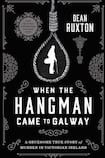
Once, in the late 1880s, a young fellow suffering from seasickness and toothache disturbed other passengers on the Holyhead boat. The stewards directed him to a well-dressed man in his thirties.
They said you could help, he said.
The man admitted that he was in the habit of giving drops that would instantaneously cure both his ailments. But he didn’t think, he added, that he would be willing to take his remedy.
The young fellow persisting, the man produced his business card: James Berry, executioner. It gave the fellow’s nerves a shock, Berry remembered, that both cured him and himself of his presence.
Between 1884 and 1891, Berry killed (politely, “executed”) 131 persons. Most he killed “cleanly”; indeed, he claimed to have perfected “long drop” hanging, whereby the length of the drop was determined by the unfortunate’s height and weight so as to break the neck. Still, some of those dispatched by Berry were strangled and one was decapitated in a gruesomely botched job.
Ghoulish glee
Berry's memoir, My Experiences as an Executioner (1892), in which he related with ghoulish glee that encounter on the ferry, has given him a certain prominence in the history of crime. Most hangmen did not court publicity, but Berry did: even before publishing his memoir, he gave interviews, when he made a show of presenting his macabre business card.
Business brought Berry to Ireland. Here, much as Secretary of State for Northern Ireland Karen Bradley has discerned, with Dorothy-like wonder, that she is not in Staffordshire anymore, he detected differences between Irish and English attitudes to the “common hangman”.
“Whenever I have been in actual contact with crowds in England, their attitude has been friendly. In Ireland, such knots of people as may gather are usually the reverse. In England, if there is any sort of demonstration it is a cheer; in Ireland, it is hooting and groaning.”
Galway, according to Berry, was the worst place to hang somebody, for not only were he and his assistant confined to the jail, but the food was “of an inferior quality”.
“I always look upon a visit to Galway Jail as the worst punishment I was ever subjected to,” he told a reporter in 1885. Still, he liked Galway’s gallows. “It is one of the largest and the best, if not the very best, structures, I have seen,” he told that same reporter. “Eight persons can be executed together on it.”
Dean Ruxton's When the Hangman Came to Galway concerns one of Berry's visits to the city, in January 1885, to hang two very different men – Michael Downey, a 25-year-old labourer, from Clonboo, Annaghdown, and Thomas Parry, a 27-year-old land steward at Edenderry.
Parry had committed murder in broad daylight. On a morning in July 1884, he entered the Royal Hotel on Eyre Square (now Supermac’s) and there, in the breakfast room, he gunned down Alice Burns, a waitress, who had just returned from a swim at Salthill. There were witnesses and the motive was clear: Burns had refused his engagement ring. The only question was Parry’s sanity – a court ruled him sane and so he was hanged.
Complicated
Downey’s case was murkier. On a night in December 1883, somebody ambushed, shot and killed John Moylan, a farmer, of Clonboo. Moylan had been some years working in America and, in his absence, his wife, Mary, had an affair with Downey. Complicating matters, Mary Moylan had allegedly solicited members of a secret society to kill her husband. Downey pleaded not guilty, but, after conviction, he confessed; for some observers, the only injustice was that Small did not hang too.
Ruxton uses these cases to illuminate crime and punishment in 19th-century Ireland, which he also does in his Irish Times series Lost Leads. He tells his story well, but it might have ended sooner: three chapters on Berry's later career could be condensed.
There is also a minor error. Capital punishment was not “scrapped” in the United Kingdom in 1969; it was only abolished for murder in that year – it remained on the statute books for espionage, piracy, treason and some military offences, and only in Britain. Then, as now, Unionists dined à la carte on British norms, and Northern Ireland retained the death penalty for murder. It was not until 1973, a year after the proroguing of Stormont (and despite Unionist objections at Westminster), that the North came into line with Britain. Incidentally, the Oireachtas, in carrying Charlie Haughey’s Criminal Justice Act, had severely limited “hanging offences” in 1964.
When the Hangman Came to Galway will engage anybody interested in post-Famine Ireland-and, for sure, there will be many well-thumbed copies around Clonboo.
Breandán Mac Suibhne is the author of The End of Outrage (Oxford, 2017)












